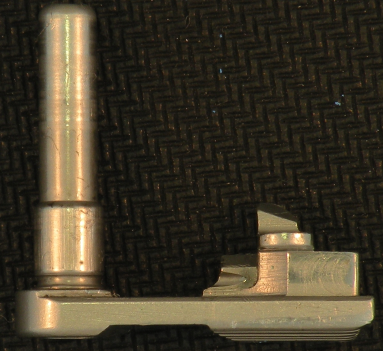|
TRBCD 37gr 'Totally Fragmenting Soft Point' |

|
Brass Fetcher Ballistic Testing |
|
Kahr P380 9mm Police Function and Casualty |
|
Know before you go... |
|
The 9x18mm Police handgun cartridge, was developed in the mid 1960’s as a high performance replacement for the 380 ACP. When fired from a mousegun, terminal ballistics equal to a .38 Special Snubnose are easily obtained. This is advantageous in that full expansion and penetration can be achieved from lightweight 9mm bullets, without having to carry around a physically larger gun. However, as a wise person once said: “There is no free lunch”. Accordingly, recoil from this cartridge can be expected to be on the order of 20-25% higher than that from a .380ACP from the same handgun.
|
|
The first phase involved shooting 200 rounds of Fiocchi 100gr FMJTC ammunition. Firing was done with no additional time allowed between shots for cooling. Immediately after firing, the weapon was disassembled, cleaned and the parts were photographed.
|

|
To this end, a factory Kahr P380 handgun was modified by the reaming of the chamber from .380ACP (9x17mm) to fire the 9x18mm Police cartridge. In anticipation of the higher operating pressures and slide velocities, a ‘worst case’ scenario of a mousegun partially composed of aluminum and polymer structural components was selected to exacerbate any sort of excessive wear that may be imposed by the Police cartridge. This role was filled by the Kahr handgun, which is a fine choice for a lightweight civilian CCW gun, but is a gun that may not have been constructed to fire many thousands of .380ACP cartridges during its service life.
The initial phase of testing began with a liquid penetrant and x-ray inspection of the slide and barrel of Kahr P380 serial number RA2906, by TEAM Industrial Services of Aston, Pennsylvania. Prior to this inspection, the weapon had not been fired (except for the proof testing that was likely done at the factory.) The result of the inspection was that no cracks were detected and the weapon was then considered to be in mechanically sound condition. After the inspection was complete, the weapon was thoroughly cleaned and relubricated in anticipation of the live fire testing.
Perhaps the most challenging aspect of this series of testing was the acquisition of the ammunition itself. Currently, the only factory load in this caliber is made by Fiocchi of Italy and this is very likely made in limited production runs. At the beginning of testing, we had 250 factory 100gr FMJTC cartridges and allotted 200 of these rounds to be fired in the initial stage of the function and casualty testing. The understanding behind this was that even the most lightly-used pocket pistols could be expected to have 200 rounds of practice FMJ, or 4 boxes of ammunition, on them and that this would be a good baseline to establish whether further testing was warranted.
In the interest of safety, all firing was done with the pistol mounted in a Ransom rest. All shots were single loaded into the chamber of the weapon due to the Fiocchi cartridges being a few thousands of an inch too long for reliable feeding. Should the 9mm Police see renewed interest by the shooting public, it was reasoned that there will be ample opportunity in the future to perfect the reliability of such guns. For the meantime, however, this test will focus on the mechanical integrity of the Kahr P380 and its suitability for this modification. |

|
After the initial firing sequence, there were no cracks visible on the frame, slide or the individual parts. What was notable, however, was the accelerated wear present on the surface of the barrel. The Kahr took a licking, but kept on ticking... |

|
Small Recoil Spring
Top - After 200 rounds Bottom – New |

|
Large Recoil Spring
Top - After 200 rounds Bottom – New |
|
Right side of Frame
After 200 rounds |
|
Left side of Frame
After 200 rounds |
|
The polymer portion of the handgun appears to be notably scored. This did not negatively influence the smoothness of hand-cycling the weapon and had no noticeable effect on the forward or rearward slide velocity during shooting. |
|
Barrel
After 200 rounds |
|
Slide Hold-Open Lever
After 200 rounds |





|
Frame (top, middle) Recoil Spring Guide Rod (bottom) After 200 rounds |



|
With no mechanical problems noted, the weapon was relubricated with CLP and reassembled. 250 rounds of Hirtenberg 100gr FMJTC and 150 rounds of a +P+ handload were subsequently fired without cleaning or allowing the weapon to cool.
The process of tearing down the weapon was repeated and a visual inspection was again performed. No additional wear and no breakages were noted.
The tested Kahr P380 is suitable for conversion to 9x18mm Police and is more than durable enough to endure firing 450 service cartridges and 150 high pressure cartridges, giving terminal performance on par with the 38 Special Snubnose revolver. |

